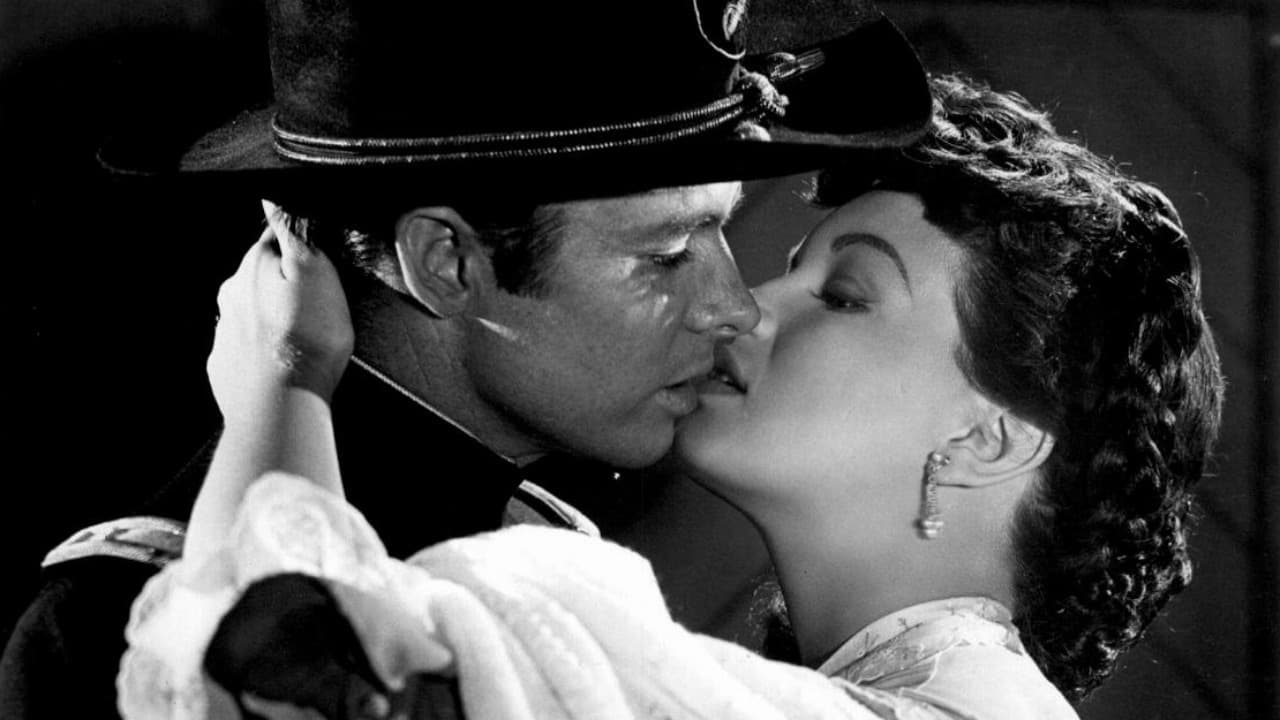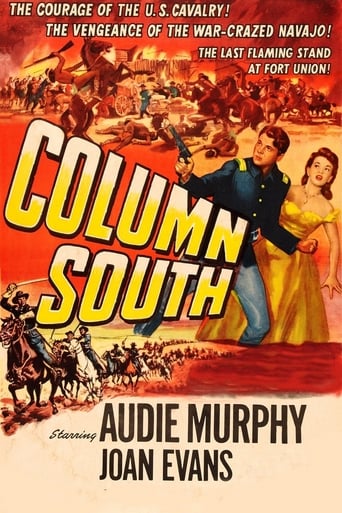

Westerns that feature a cavalry theme don't hold much attraction for me but this one managed to hold my attention. It has an above average story by William Sackheim that helps - an above average and hard working cast, with above average photography by D.O.P. the Award nominated Charles P. Boyle (Anchors Aweigh '45)The DVD copy I was given by a friend is from the Umbrella series: Six Shooter Classics (they really must do something about that silly marketing title). Universal originally used the magnificent IB Technicolor process for this film but this disc is well below average (compared with Umbrella's earlier 'Tumble Weed' that looked perfect). Sound transfer is also below standard. Robert Sterling ('Roughshod' '49) is good as the Fort Commander, with good support from Ray Collins, Greg Palmer (Lee) and Joan Evans. Dennis Weaver does very well as the Indian chief with his motley Hollywood tribe. Music is mostly from the Universal stock library and offers little help. Audie Murphy is reliable as always in his way. Veteran director Frederick De Cordova keeps things moving and probably helped with the good dialogue (as he was known to do). Have certainly seen far worse.
... View MoreThe title presumably refers to the peaceful departure of Confederate sympathizers among the Union army at Ft. Union, NM Territory, upon news that war had broken out between the Union and CSA. However, it may also refer to the prior southward troop march from Ft. Union toward Ft. Stanton, supposedly to deal with the increased Apache hostility, but actually to join Confederate troops in nearby Texas. The historic General Sibley, who had served before the war in trying to subdue the Navajoes, did resign his position, along with other Confederate-sympathizers, and led the campaign, mostly staffed by Texans, to conquer NM Territory for the CSA.The plot alludes to and combines several distinct historically relevant happenings just prior to and during the early phases of the Civil War in the New Mexico Territory, which then included the later state of Arizona. However, it fails to mention the historical secession of the southern half of NM territory, dubbed Arizona, later incorporated into the CSA as a provisional territory. Initial military events supported the legitimacy of this political entity. But, due to subsequent military reversals, this entity essentially ceased to exist by April '62. The Navajos and Apaches did step up depredations on settlers and the army in this area during the Civil War, after many troops were evacuated to serve in the East. However, the central involvement of General Stone in the film in engineering 'Indian' hostilities and supply shortages to weaken the ability of Union forces to resist a planned Confederate invasion from Texas is pure fiction, if adding considerable interest to the plot. There was a historical Ft. Union, to the east of Santa Fe, which did play a significant role in Civil War hostilities. However, in the film, it takes on the character of historic Ft. Defiance, which was established in the heart of Navajo territory to discourage depredations on nearby settlers. As in the film, a large Navajo force did attack Ft. Defiance around this time, although they didn't capture it, as in the film. One of the chiefs in this raid was named Manulito, which somewhat resembles the Navajo chief Menguito in the film, played by Dennis Weaver. The forced relocation of Menguito's Navahos in the film to the hated 'Yellow Spring' has a historical corollary in their forced 'Long Walk' to a hated reservation near Ft. Sumner late in the Civil War. They were repatriated in part of their homeland in 1868. These drawn out events are compressed into a short time period in the film. Thus, the happy ending for Menguito's surviving Navajos in the film takes place in 1861 instead of 1868. The Confederate plan discussed by General Stone, to initially capture NM Territory, then capture the rest of the southern portion of the West, and prevent shipments of gold and silver east to support the Union war effort, has a historical basis. Portly, folksy, veteran character actor Ray Collins plays the traitorous General Stone. Poetic justice is served in the General's ultimate fate in the film. General Stone can be thought of as incorporating aspects of 3 historical personages: the thoroughly Yankee blue-blood General Carleton; General Sibley, who tried to conquer NM Territory for the CSA; and, much more obliquely, the (past) second president of the Texas Republic, Lamar, who much earlier dreamed of extending his nation to the Pacific Ocean.We might think of Audie Murphy's character(Lt. Jed Sayre) as representing a modified Kit Carson, who served as chief Indian Agent in northern NM Territory before the war, then led army raids against the Apache and Navajos during the war. Like Lt. Sayre, Kit was sympathetic to the 'Indian's' interests, but recognized that their depredations on settlers had to be brought under control. Audie tends to exhibit a stiff smug know-it-all presence. In part, it's justified in this film, because Lt. Sayre has had long experience with the local Navajo, whereas his new commanding officer, Capt. Whitlock(Robert Sterling) is fresh from the Southeast, and subscribes to the the 'Indians' as vermin mentality. The relationship between Lt. Sayre and Captain Whitlock very much reminds us of that between Captain York and Colonel Thursday in the previous "Fort Apache", among some other film examples among westerns. Handsome Robert Sterling is fine in his role as the insecure new fort commander, who reluctantly agrees to act as one of General Stone's puppets in his grand scheme of conquest.Of course, there is a woman included, although she plays a very subsidiary role as someone Lt. Sayre initially hates, then gradually falls in love with. Joan Evans as Captain Whitlocks's sister, initially suffers from severe culture shock in this primitive Navajo-ridden fort and surrounds. She's certainly not likable. But, she undergoes a sudden change in attitude after learning Lt. Sayre's reason for standing up for the Navajos and importance in preventing her brother from suicidal encounters with the Navajos. Just why she arrived with her brother is unclear. Awkward!In all, I found it an enjoyable Technicolor film, with an interesting plot with some historical relevance. Dennis Weaver was quite good and convincing as the Navajo chief. It does lack any substantial musical or humorous elements. However, "Dixie" and "John Brown's Body" are sung simultaneously by southern vs. Yankee pre-Civil War soldiers, at one point.Presently viewable at You Tube, and perhaps Encore Westerns
... View MoreIf I remember well, in this movie - and perhaps I confound with another Audie Murphy film directed by Nathan Juran: TUMBLEWEED, there is something very unusual in this little feature. In a sequence, the Indians are inside the fort and are attacked by US cavalry !!!Isn't it interesting? I watched it when I was a kid and I was shocked at this time. In the meanwhile, I got this film, but it is lost in my collection and I have no time to search it. Actually, I have them both. If I am wrong, if the sequence of Indians fighting IN the fort against US cavalry - at the OUTSIDE - is in TUMBLEWEED I hope an IMDb user will tell me my error.Thanks
... View MoreTaking place just prior to the start of the civil war, Audie Murphy plays a junior army officer who is sympathetic to the plight of the local Navajo Indians and is a good friend of Navajo chief Menquito. A new commanding officer who is from the south is appointed to the post who convinced by Confederate agitators to stir up trouble with the Navajo Indians and send Audie and large column troops out on wild goose chase so the Confederates can gain control of the western territories. Of course Audie gets wind of nefarious plot and prevents further bloodshed.This film would be an otherwise routine "Indians unjustly forced to go on the warpath by scheming white men" story, had it not been for the Confederate conspiracy angle. Audie Murphy is well... Audie Murphy. If you like Audie Murphy (I do) you will like him here. If you don"t there is no reason why you should like him here. Robert Stirling and Joan Evans are unconvincing as Southerners. Their Southern accents vary through out the film. Film buffs will enjoy seeing many familiar faces in the cast (Bob Steele, Greg Palmer, Russell Johnson, Dennis Weaver and Ray Collins.)
... View More